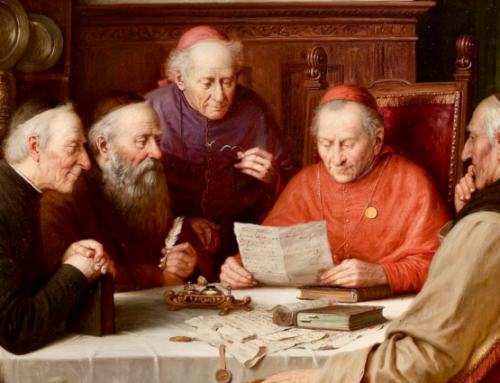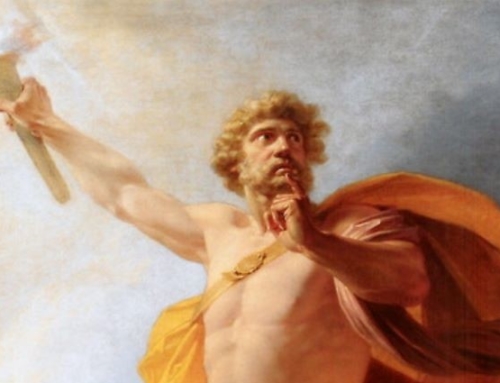“Christopher Dawson viewed the disintegration of Western culture as a far worse disaster than that of the fall of Rome,” biographer Christina Scott writes. “For the one was material; the other would be a spiritual disaster which would strike directly at the moral foundations of our society and destroy not the outward form of civilization but the soul of man, which is the beginning and the end of all human culture.”
A Historian and His World: A Life of Christopher Dawsonby Christina Scott. With a new introduction by Russell Kirk, and a postscript by Christopher Dawson: “Memories of a Victorian Childhood.”
 Christopher Dawson was the most illustrious Catholic historian of our century. He was perhaps the last of a breed of freelance scholars and writers (e.g. Hume, Gibbon, and in our time, Russell Kirk) whose greatness was made possible in large measure precisely because he avoided the narrow and often petty constraints of professional, academic institutions. Dawson did not hold a full-time academic post until he was nearly seventy years old, when he accepted the Stillman Chair of Roman Catholic Studies at Harvard, where he lectured from 1958–1962. This biography, competently and beautifully written by his daughter, Christina Scott, is a fine account of Dawson’s life and thought.
Christopher Dawson was the most illustrious Catholic historian of our century. He was perhaps the last of a breed of freelance scholars and writers (e.g. Hume, Gibbon, and in our time, Russell Kirk) whose greatness was made possible in large measure precisely because he avoided the narrow and often petty constraints of professional, academic institutions. Dawson did not hold a full-time academic post until he was nearly seventy years old, when he accepted the Stillman Chair of Roman Catholic Studies at Harvard, where he lectured from 1958–1962. This biography, competently and beautifully written by his daughter, Christina Scott, is a fine account of Dawson’s life and thought.
Dawson was born at Hay Castle, in Wales, on 12 October 1889. Built in the twelfth century, the castle stood in a town that still had a Welsh-speaking population. From his mother, the daughter of an arch-Protestant Anglican clergymen, he learned a pietas toward the Welsh cultural and religious tradition. From his father, an Anglo-Catholic military officer, he inherited a respect for the Catholic tradition, to which Dawson would convert in 1914. He would later write of his early childhood in Wales: “In fact it was then I acquired my love of history, my interest in the differences of culture and my sense of the importance of religion in human life, as a massive, objective, unquestioned power that entered into everything and impressed its mark on the external as well as the internal world.”
Even in these early years we find one of the most distinctive traits of Dawson’s mind. Unlike many of the lights in the firmament of the Catholic revival of the 1930s—e.g., Maritain, Gilson, Rousselot, and Ronald Knox—Dawson eschewed abstract philosophy and systematic theology. Of course he respected these as important expressions of intellectual and scientific order. From the very outset of his life, however, Dawson was drawn to the cultural, historical, aesthetic, and even mystical elements of Christianity. For example, we learn from the biography that his first literary composition, written at the age of six, was an allegorical story about “The Golden City and the Coal City,” which described a struggle between Christians and heathens. We also learn that when he went up to Oxford in 1908, quite fortunately taking as a tutor the Aristotelian scholar Ernest Barker, Dawson chiefly devoted himself to the study of lives of the mystics and saints rather than philosophy.
Nothing, however, was more formative during his Oxford years than his reading of St. Augustine’s City of God. Dawson was imbued with an Augustianian sense of history as a moral and spiritual drama. It was this sensibility, when combined with his training in sociology and in the best methods of historical research, that accounted for Dawson’s genius. His two well-known essays on St. Augustine, “The Dying World,” and the “City of God,” republished in Enquiries into Religion and Culture (1933), are, in my estimation, unsurpassable—both in terms of their sense of St. Augustine, and in their Augustinian sense of history. If it is still possible for someone to be an Augustinian, Dawson was the real item.
During Easter vacation 1909, when he was nineteen, Dawson visited the church of the Ara Coeli in Rome. Sitting on the steps of the Capitol, in the same place where Gibbon had been inspired to write The Decline and Fall, Dawson vowed to write a history of culture. Returning to England, he eventually married Valery Mills and was received into the Catholic Church on the eve of the Feast of the Epiphany, January, 1914. Then began a lonely fourteen years of study in preparation for his projected history of culture. It was a difficult period because Dawson worked without a full-time university post. Indeed, his first bid for such a position, at the University of Leeds in the early 1930s, was rejected because of his Catholicism.
The fourteen-year period of gestation bore excellent results. Beginning with his first published work, Age of the Gods (1928), a stream of publications would follow, including: Progress and Religion (1929), The Making of Europe (1932), Spirit of the Oxford Movement (1933), Enquiries into Religion and Culture (1933), and Religion and the Modern State (1939), to mention only a few of the more prominent books. In these books, the general contours of Dawson’s project became apparent. He contended (i) that religion is not a by-product of culture, but is rather the animating form of cultures worldwide, (ii) that the career of European culture is to be explained by a common religion, that allowed the various tribes and ethnic interests to transcend the materially limiting pressures of race, language, and property, and (iii) that modern Europe, having rejected the Christian religion, has devolved into a racial and tribal maelstrom, controlled only by the material forces of technology, economics, and armed force.
At the time of the Second World War, Dawson was appointed editor of the Dublin Review. He used his editorial office to good effect, by fostering cooperation between politically left- and right-wing Christians of various denominations, and by urging his co-religionists to get a proper perspective on the events of the War. In numerous articles, as well as in his book Judgement of the Nations (1942), Dawson repeatedly warned that totalitarianism is both the heresy of making the state man’s final end, as well as the illusion of thinking that cultural pathologies can be addressed merely by technology.
After the war, Dawson received well-deserved recognition for his scholarly work. In 1947 he gave the prestigious Gifford Lectures at Edinburgh University. These lectures were published under the titles Religion and Culture (1948), and Religion and the Rise of Western Culture (1950). Particularly in the latter book, Dawson discussed what we, in the late twentieth century, can learn from the so-called “dark ages,” when the primitive social conditions of Europe held the potential for being formed into a great civilization. To the end of his life, he insisted that the twentieth century is as volatile, and because of technology, perhaps more fraught with danger than, the original “dark ages.”
From 1958–1962, Dawson was the first incumbent of the Stillman Chair of Roman Catholic Studies, at Harvard. His Harvard lectures would later appear under the titles The Dividing of Christendom (1965), and The Formation of Christendom (1967). These books are among the best he wrote. He was especially keen to show how cultural forces are a principal cause of ecclesiastical schisms. Heresy, he contended, cannot be understood merely in terms of systematic theology.
The subject of education was also of particular interest during his American sojourn. The Crisis of Western Education (1961) allowed Dawson access to the discussion going on in the Catholic system, where such men as John Mulloy and Bruno Schlesinger urged curricular reforms based on Dawson’s ideas. Though Dawson flourished during a golden moment of Catholic intellectual life—the biography relates his business and friendship with Ronald Knox, E. I. Watkin, T. S. Eliot, Fr. Martin D’ Arcy, Frank Sheed and Maisie Ward, Evelyn Waugh, David Jones, C. S. Lewis, and a host of lesser lights—his relation to the bureaucracies and officials in the Church was not always a happy one. He encountered a certain narrowness and mediocrity that must have taxed his loyalty.
 In any event, Dawson had the singular misfortune of being regarded by some Catholic educators as perhaps too progressive in matters of education, because of his emphasis on history and culture rather than philosophy, and then, by the early 1960s, as being too conservative because of his emphasis upon the theme of Christian culture. There is something quietly, but profoundly, tragic about Dawson’s American experience. Here was a refined English Catholic, whose career was limited in England by anti-Catholicism (of the old-fashioned sort), whose majestic writings were sometimes tossed off by reviewers as the work of a “Catholic publicist”, who by the end of his career had achieved the most prestigious university post held by any Catholic in the world—but, at the end, was spurned by some American Catholics as being insufficiently relevant to the spirit of the age. The moral of the story of the Vatican II era is summarized in the events of Dawson’s later life.
In any event, Dawson had the singular misfortune of being regarded by some Catholic educators as perhaps too progressive in matters of education, because of his emphasis on history and culture rather than philosophy, and then, by the early 1960s, as being too conservative because of his emphasis upon the theme of Christian culture. There is something quietly, but profoundly, tragic about Dawson’s American experience. Here was a refined English Catholic, whose career was limited in England by anti-Catholicism (of the old-fashioned sort), whose majestic writings were sometimes tossed off by reviewers as the work of a “Catholic publicist”, who by the end of his career had achieved the most prestigious university post held by any Catholic in the world—but, at the end, was spurned by some American Catholics as being insufficiently relevant to the spirit of the age. The moral of the story of the Vatican II era is summarized in the events of Dawson’s later life.
After a stroke in 1962, Dawson resigned from Harvard, and returned to England, where he would live, semi-crippled, until 1970. Sunk in a coma on his deathbed, Dawson awoke for one lucid moment. His sister recalls: “All of a sudden he opened his eyes and staring at the painting of the crucifixion, which was on the wall at the foot of his bed, he had a beautiful smile and his eyes were wide open. He then said: ‘This is Trinity Sunday. I see it all and it is beautiful.’” His biographer notes that he had been unconscious, and could not have known it was Trinity Sunday.
A Historian and His World is nicely written and produced. It contains a good bibliography of Dawson’s writings, brief pieces by Russell Kirk and James Oliver, and the posthumously published memoir of Dawson about his childhood. Thanks are due to Transaction Publishers for bringing this book into print for the American audience.
“[Dawson] viewed the disintegration of Western culture as a far worse disaster than that of the fall of Rome. For the one was material; the other would be a spiritual disaster which would strike directly at the moral foundations of our society and destroy not the outward form of civilization but the soul of man, which is the beginning and the end of all human culture.” —A Historian and His World
Republished with gracious permission from the University Bookman (Volume 33, Number 4, 1993).
This essay was first published here in March 2011.
The Imaginative Conservative applies the principle of appreciation to the discussion of culture and politics—we approach dialogue with magnanimity rather than with mere civility. Will you help us remain a refreshing oasis in the increasingly contentious arena of modern discourse? Please consider donating now.
The featured image is “Clio, Muse of History” (1632) by Artemisia Gentileschi, and is in the public domain, courtesy of Wikimedia Commons.







Leave A Comment